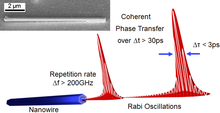| Part of a series of articles on |
| Nanoelectronics |
|---|
| Single-molecule electronics |
| Solid-state nanoelectronics |
| Related approaches |
| Portals |
|
|

Semiconductor nanowire lasers are nano-scaled lasers that can be embedded on chips and constitute an advance for computing and information processing applications. Nanowire lasers are coherent light sources (single mode optical waveguides) as any other laser device, with the advantage of operating at the nanoscale. Built by molecular beam epitaxy, nanowire lasers offer the possibility for direct integration on silicon, and the construction of optical interconnects and data communication at the chip scale. Nanowire lasers are built from III–V semiconductor heterostructures. Their unique 1D configuration and high refractive index allow for low optical loss and recirculation in the active nanowire core region. This enables subwavelength laser sizes of only a few hundred nanometers.[1][2] Nanowires are Fabry–Perot resonator cavities defined by the end facets of the wire, therefore they do not require polishing or cleaving for high-reflectivity facets as in conventional lasers.[1]
YouTube Encyclopedic
-
1/3Views:14 7501 730602 050
-
Making Quantum Light with Quantum Dots
-
New nanowire architectures boost computers' processing power
-
Photolithography: Step by step
Transcription
Properties
Nanowire lasers can be grown site-selectively on Si/SOI wafers with conventional MBE techniques, allowing for pristine structural quality without defects. Nanowire lasers using the group-III nitride and ZnO materials systems have been demonstrated to emit in the visible and ultraviolet, however infrared at the 1.3–1.55 μm is important for telecommunication bands.[3] Lasing at those wavelengths has been achieved by removing the nanowire from the silicon substrate.[2] Nanowire lasers have shown pulse durations down to <1ps,[4] and enable repetition rates greater than 200 GHz.[5][6] Also, nanowire lasers have shown to store the phase information of a pulse over 30ps when excited with subsequent pulse pairs. Mode locked lasers at the nano-scale are therefore feasible with such configurations.
See also
References
- ^ a b Ning, C. Z. (2012). "Semiconductor Nanowire Lasers". Semiconductors and Semimetals. 86: 455–486. doi:10.1016/B978-0-12-391066-0.00012-5. ISBN 9780123910660. ISSN 0080-8784.
- ^ a b Yan, Ruoxue; Gargas, Daniel; Yang, Peidong (2009). "Nanowire photonics". Nature Photonics. 3 (10): 569–576. doi:10.1038/nphoton.2009.184. S2CID 2481816.
- ^ Koblmüller, Gregor; Mayer, Benedikt; Stettner, Thomas; Abstreiter, Gerhard; Finley, Jonathan J. (2017). "GaAs–AlGaAs core–shell nanowire lasers on silicon: invited review". Semiconductor Science and Technology. 32 (5): 053001. Bibcode:2017SeScT..32e3001K. doi:10.1088/1361-6641/aa5e45. ISSN 0268-1242. S2CID 99074531.
- ^ Sidiropoulos, Themistoklis P. H.; Röder, Robert; Geburt, Sebastian; Hess, Ortwin; Maier, Stefan A.; Ronning, Carsten; Oulton, Rupert F. (2014-09-28). "Ultrafast plasmonic nanowire lasers near the surface plasmon frequency". Nature Physics. 10 (11): nphys3103. Bibcode:2014NatPh..10..870S. doi:10.1038/nphys3103. hdl:10044/1/18641. S2CID 121825602.
- ^ Mayer, B.; Janker, L.; Loitsch, B.; Treu, J.; Kostenbader, T.; Lichtmannecker, S.; Reichert, T.; Morkötter, S.; Kaniber, M. (2016-01-13). "Monolithically Integrated High-β Nanowire Lasers on Silicon". Nano Letters. 16 (1): 152–156. Bibcode:2016NanoL..16..152M. doi:10.1021/acs.nanolett.5b03404. ISSN 1530-6984. PMID 26618638.
- ^ Mayer, B.; Regler, A.; Sterzl, S.; Stettner, T.; Koblmüller, G.; Kaniber, M.; Lingnau, B.; Lüdge, K.; Finley, J. J. (2017-05-23). "Long-term mutual phase locking of picosecond pulse pairs generated by a semiconductor nanowire laser". Nature Communications. 8: ncomms15521. arXiv:1603.02169. Bibcode:2017NatCo...815521M. doi:10.1038/ncomms15521. PMC 5457509. PMID 28534489.
